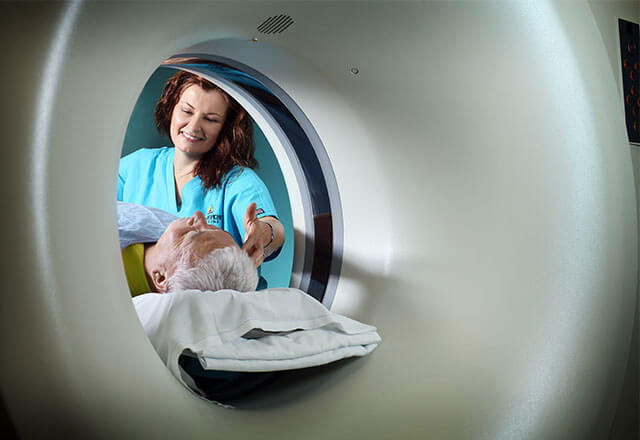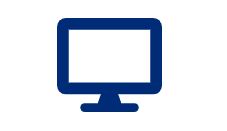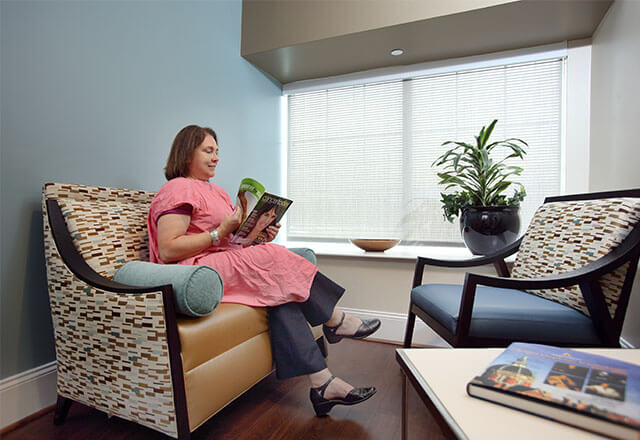Exams We Offer: Image-Guided Breast Biopsy

Routine self-exams and mammograms are important to keep your breasts healthy. If an abnormality is found, your doctor might order a biopsy to see a more detailed view of the breast tissue. An image-guided breast biopsy removes a small sample of breast tissue or cells for examination under a microscope to see if cancer or other abnormalities are present.
The type of imaging used for your biopsy will depend on the location of the abnormality and how it is best seen. Your doctor may use a mammogram, ultrasound or MRI for the procedure.
Request An Appointment Request An Appointment
Schedule by phone

How do I prepare for an image-guided breast biopsy?
-
The breast imaging specialist will explain the procedure to you and give you a chance to ask any questions you might have.
- You will be asked to sign a consent form that gives your permission to do the procedure. Read the form carefully and ask questions if something is not clear.
- Don’t use lotion, cream, powder, deodorant, or perfume on your arm, underarm, or breast on the day of the procedure.
- Tell your provider if you are pregnant or think you may be pregnant.
- Tell your provider if you are sensitive to or allergic to any medicines, latex, tape, and local anesthesia medicines.
- Tell your provider about all the medicines you take. This includes both over-the-counter and prescription medicines. It also includes vitamins, herbs, and other supplements.
- Tell your provider if you have a history of bleeding disorders. Let your provider know if you are taking any blood-thinning medicines, aspirin, ibuprofen, or other medicines that affect blood clotting. You may need to stop taking these medicines before the biopsy.
- If you have a sedative or general anesthesia, make sure you have someone drive you home afterward. You will not be able to drive after the biopsy.
- Your health care provider may have other instructions for you based on your medical condition.
-
-
Generally, a needle breast biopsy follows this process:
- You will be asked to remove any clothing from the waist up, and given a gown to wear.
- You will lie down or sit up. This depends on your provider’s preference and if X-ray or ultrasound guidance will be used.
- The skin over the biopsy site will be cleaned with a sterile solution.
- When a local anesthetic is used, you will feel a needle stick when the medicine is injected. You may feel a brief stinging feeling. The biopsy will not start until the area is numb.
- When ultrasound is used, the probe will be placed on your breast to find the breast lump or mass.
- When stereotactic imaging is used, you will lie face down with your breast placed in an opening on the table. A computer will find the exact site of the breast lump or area of concern.
- You will need to lie still during the procedure. But you won’t need to hold your breath.
- The provider will place the needle right into the biopsy site or through a tiny cut (incision). He or she will remove a sample of tissue or fluid. You may feel pressure when the doctor takes the sample.
- Pressure will be applied to the biopsy site after the biopsy is completed until the bleeding stops.
- If needed, the opening will be closed with stitches or adhesive strips.
- A sterile bandage or dressing will be applied.
- The tissue specimen will be sent to the pathology lab for examination.
-
-
You should plan to have another person drive you home. Keep the biopsy area clean and dry. You may remove the bandage or dressing when instructed to do so, and bathe as normal.
The biopsy site may be sore for several days after surgery. Take a pain reliever as recommended by your doctor. Aspirin or certain other pain medicines may increase your chance of bleeding. Be sure to take only recommended medicines. Wearing a supportive bra may help with mild pain.
You may go back to your normal diet unless your doctor advises you differently. You may be told to avoid strenuous physical activity for a few days.
Call your health care provider if you have any of the following:
- Fever or chills
- Redness, swelling, bleeding or other drainage from the biopsy site
- Increased pain around the biopsy site
Your health care provider may give you other instructions, depending on your situation. You will be notified of your results by phone a few days after your biopsy.
Why Choose Johns Hopkins Medical Imaging?
Physician Experts

#1 Radiology Department
State-of-the-Art Technology

Your Safety Is Always Our Priority

Specialty Technologists

Patient Care



